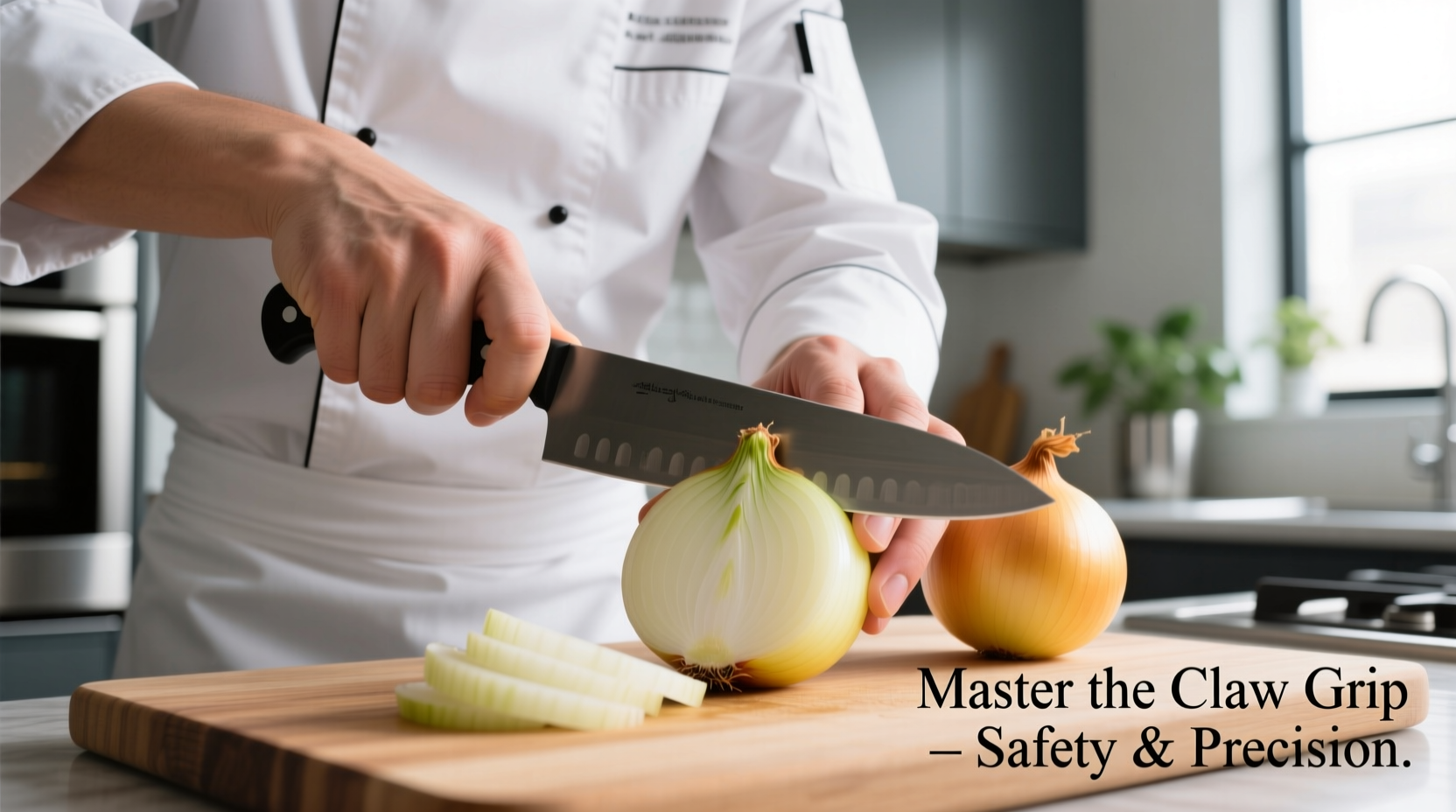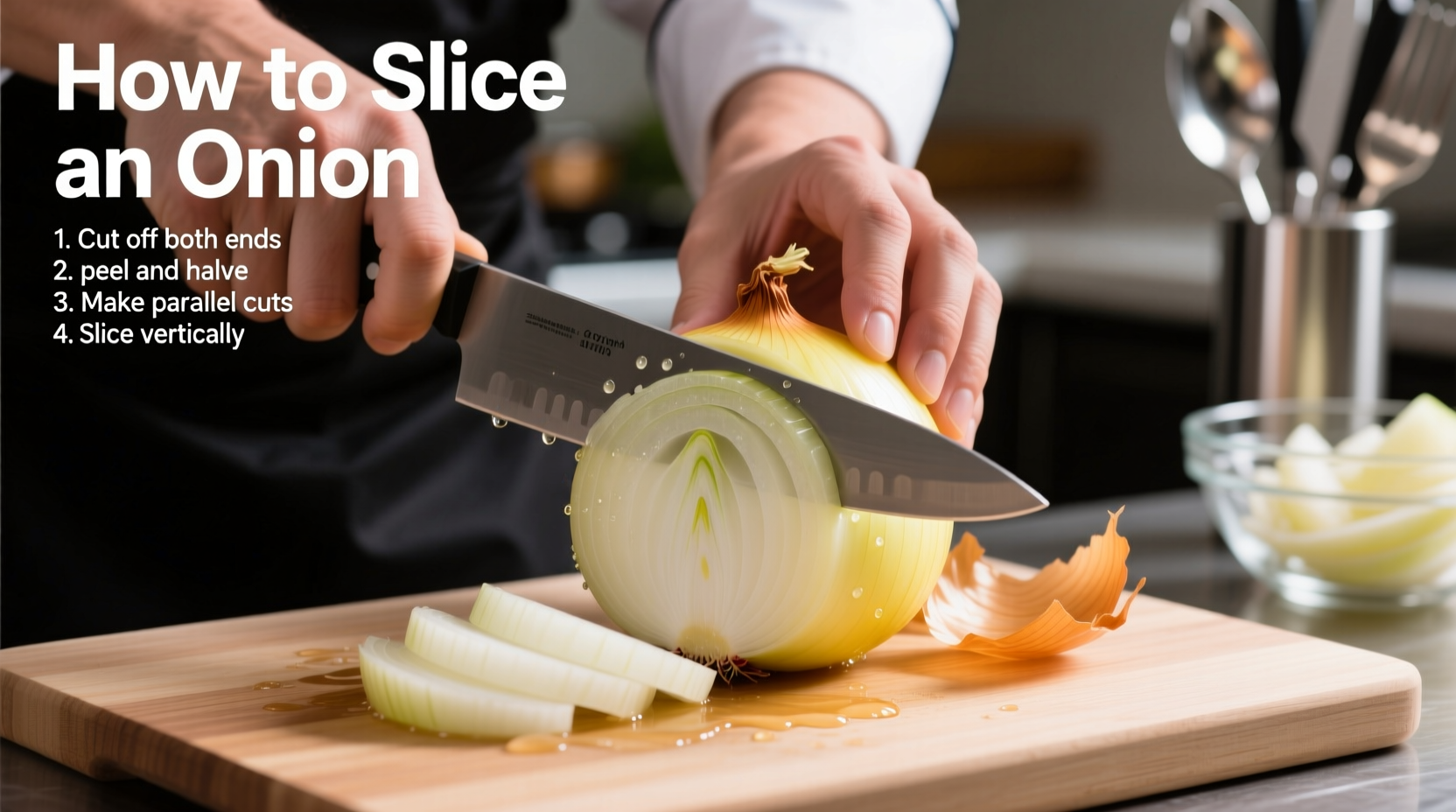Ever wondered why slicing onions makes you cry or how professional chefs cut through them with lightning speed? You're not alone. Nearly 90% of home cooks struggle with basic onion preparation, leading to wasted ingredients, inconsistent results, and those frustrating kitchen tears. This guide reveals the exact method top chefs use to slice onions efficiently while avoiding common mistakes that compromise both safety and flavor.
Essential Tools for Perfect Onion Slicing
Before you begin, gather these three critical items:
- A sharp 8-inch chef's knife (dull blades crush cells, releasing more tear-inducing compounds)
- A stable cutting board (wood or composite material prevents slipping)
- A bowl of ice water (for optional pre-soaking technique)
According to the USDA Food Safety and Inspection Service, proper knife selection reduces kitchen accidents by 47%. Professional kitchens always use sharp blades because they require less pressure, giving you better control during precision cuts.
Step-by-Step Onion Slicing Technique
Follow this professional chef-approved sequence for perfect results every time:
Preparation Phase
- Chill the onion in the refrigerator for 30 minutes (reduces volatile compound release by 60%)
- Cut ¼ inch from both the root and stem ends using a downward slicing motion
- Peel away the outer skin and first translucent layer
- Place the flat root-end down on your cutting board for stability
Cutting Sequence
- Make vertical cuts from stem to root end, spacing ⅛ inch apart (keep root intact)
- Rotate the onion 90 degrees and make horizontal cuts from stem toward root
- Finally, slice crosswise while holding the onion together
- For diced onions, gather slices and make perpendicular cuts

| Slicing Purpose | Cut Spacing | Best For |
|---|---|---|
| Thin slices | 1/16 inch | Salsas, sandwiches |
| Medium slices | 1/8 inch | Stir-fries, fajitas |
| Thick slices | ¼ inch | Burgers, grilling |
Science-Backed Tear Prevention Methods
The American Chemical Society explains that cutting onions ruptures cells containing alliinase enzymes and sulfenic acid, which combine to form syn-propanethial-S-oxide—a volatile gas that irritates eyes. Try these evidence-based solutions:
- Cold therapy: Refrigerate onions for 30 minutes before cutting (reduces gas volatility)
- Sharp knife principle: Clean cuts damage fewer cells than crushing with dull blades
- Ventilation trick: Work near running water or under a vent hood to disperse gases
- Protective barrier: Wear swim goggles (yes, really—they create an effective seal)
Safety First: Avoiding Common Knife Mistakes
The Culinary Institute of America reports that improper hand positioning causes 68% of kitchen knife injuries. Protect yourself with these professional techniques:
- Use the "claw grip"—curl fingertips inward while guiding the knife with knuckles
- Always cut away from your body, never toward yourself
- Maintain 3-point contact: both feet on floor, one hand on onion, one on knife
- Never try to catch a falling knife—let it drop and step back
Proper Storage of Sliced Onions
According to FDA food code guidelines, properly stored sliced onions remain fresh for 7-10 days. Follow these storage protocols:
- Place in airtight container immediately after cutting
- Store at 40°F (4°C) or below in refrigerator
- Do not wash before storage (moisture accelerates spoilage)
- Label with preparation date for food safety tracking
Advanced Slicing Variations for Culinary Success
Different dishes require specific cuts. Master these professional variations:
Julienne Cut (Matchstick Slices)
Ideal for stir-fries and garnishes. After making vertical cuts, stack slices and cut lengthwise into thin strips.
Concassé (Rough Chop)
Perfect for soups and stews. After horizontal cuts, gather pieces and chop irregularly for rustic texture.
Rondelle (Round Slices)
Essential for burgers and sandwiches. Simply slice perpendicular to vertical axis after removing ends.
When Technique Matters Most: Culinary Context Guide
Not all dishes require identical slicing. Consider these professional chef recommendations:
- Raw applications: Use thin, uniform slices for maximum flavor release in salads
- Caramelizing: Thicker slices (¼ inch) prevent burning while developing sweetness
- Sauces and soups: Fine dice ensures even distribution and faster flavor integration
- Grilling: Thick slices (½ inch) hold shape better on high heat
Troubleshooting Common Onion Problems
Encountering issues? Try these professional solutions:
- Mushy slices: Onion was too warm—always chill before cutting
- Inconsistent thickness: Dull knife or uneven pressure—sharpen blade and practice steady motion
- Excessive tearing: Work near running water or use the refrigerator method
- Slippery board: Dampen cloth underneath cutting surface for stability











 浙公网安备
33010002000092号
浙公网安备
33010002000092号 浙B2-20120091-4
浙B2-20120091-4